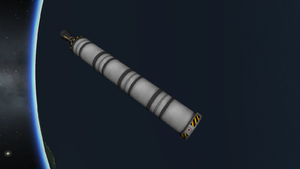Difference between revisions of "Debris/de"
Kerbolytic (talk | contribs) (→Quellen) |
Kerbolytic (talk | contribs) (→Quellen) |
||
| Line 10: | Line 10: | ||
Trümmer können mit Hilfe der [[Tracking Station/de|Tracking-Station]] beobachtet werden. Beachte, dass der Standardfilter Trümmer ausblendet. | Trümmer können mit Hilfe der [[Tracking Station/de|Tracking-Station]] beobachtet werden. Beachte, dass der Standardfilter Trümmer ausblendet. | ||
| + | Um Rückstände zu entfernen, kann er über die [[Tracking Station/de|Tracking-Station]] zurückgewonnen oder entfernt werden. Die '''Wiederherstellen''' Option ist nur für Trümmer verfügbar, das auf [[Kerbin]] gelandet sind. Andernfalls kann die Option '''Beenden''' die Trümmer aus dem Spiel entfernen. Dabei wird die sich an Bord befindliche Crew tötet und als “Verloren” im Astronauten-Komplex angezeigt. | ||
| − | + | Das Spiel setzt verworfene Stufen automatisch als Trümmer ab, wenn sie kein [[Kommandomodul]] haben. | |
The game automatically sets discarded stages as debris when they have no [[command module]]. For example [[TT18-A Launch Stability Enhancer]]s are usually debris after launch. With {{version|0.22}} debris on the [[Runway]] or [[Launch Pad]] get automatically removed, when a new craft gets prepared to start. This includes the launch clamps eliminating the requirement to manually confirm that they can be removed. | The game automatically sets discarded stages as debris when they have no [[command module]]. For example [[TT18-A Launch Stability Enhancer]]s are usually debris after launch. With {{version|0.22}} debris on the [[Runway]] or [[Launch Pad]] get automatically removed, when a new craft gets prepared to start. This includes the launch clamps eliminating the requirement to manually confirm that they can be removed. | ||
Revision as of 11:12, 22 February 2018
Als Trümmer (Debris) werden all die Raumschiffteile bezeichnet, die nach einer Abkopplung, Absprengung oder Loslösung vom Raumfahrzeug im All verbleiben und nicht mehr mit einem Kommandomodul verbunden sind.
Quellen
Trümmer werden normalerweise bei Abkopplungen zurück gelassen. Sie können auch als Hinterlassenschaften katastrophaler Misserfolge entstehen. Trümmer werden automatisch nach folgendem Schema benannt: “<Name des verursachenden Fahrzeugs> Debris” Trümmer kann auch ein Schiff sein, das ohne Kommando-Modul gestartet wurde. In diesem Fall enthält das Fahrzeug im Namen nicht das Suffix "Debris".
Wie bei allen Objekten wird der Schwung der Trümmern bis zum Stillstand und somit seine Trajektorie in einem Orbit oder bis zu einem Einschlag fortgesetzt. Trümmer können mit Hilfe der Tracking-Station beobachtet werden. Beachte, dass der Standardfilter Trümmer ausblendet.
Um Rückstände zu entfernen, kann er über die Tracking-Station zurückgewonnen oder entfernt werden. Die Wiederherstellen Option ist nur für Trümmer verfügbar, das auf Kerbin gelandet sind. Andernfalls kann die Option Beenden die Trümmer aus dem Spiel entfernen. Dabei wird die sich an Bord befindliche Crew tötet und als “Verloren” im Astronauten-Komplex angezeigt.
Das Spiel setzt verworfene Stufen automatisch als Trümmer ab, wenn sie kein Kommandomodul haben.
The game automatically sets discarded stages as debris when they have no command module. For example TT18-A Launch Stability Enhancers are usually debris after launch. With Version 0.22 debris on the Runway or Launch Pad get automatically removed, when a new craft gets prepared to start. This includes the launch clamps eliminating the requirement to manually confirm that they can be removed.
If debris has a docking port, the resources the object contains can be recovered by docking to it, though the docking craft will need appropriate storage tanks or batteries and enough open capacity for the resources. As of Version 0.23.5, resources can also be reclaimed from debris lacking a docking port by craft with an Advanced Grabbing Unit.
Prevention
It is desirable to avoid creating debris so that processing power is not wasted. This can be achieved with various tactics. One is to decouple before the orbit is stable, so that the debris falls back and either collides with the surface or gets slowed down by the atmosphere. To get slowed down, the debris has to be loaded, so in most cases it has to be active. It is also possible to add a command module and keep some leftover fuel in the tank. With the leftover fuel and command module the debris can do a retro burn making the orbit unstable. It is also possible to add a docking port and send a small vessel to dock with it and deorbit it by performing the retro burn with the small vessel. As spent rocket stages are relatively light, compared to their mass when fully fueled, the thrust and fuel needed to deorbit is low compared to the thrust the stage produced before jettisoned.
Any debris not within 2.5 km (the physics range) of the active vessel, will be removed if it is in an atmosphere with atmospheric density of greater than 0.1 atm. On Kerbin this corresponds to an altitude of around 23 km. This can be an annoyance to players who want to recover spent stages in career mode.
The default quantity of tracked objects is set to 250, but can be changed in the Settings menu. But as even the small Kerbol System is so huge, random collisions are unlikely. Also because crashing debris can only generate part sized remains or completely disappear there is no hazard of having a large amount of very small fragments.
